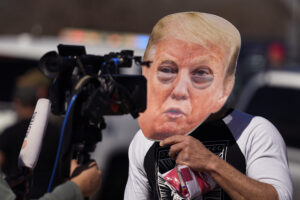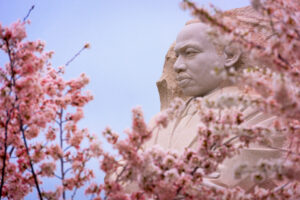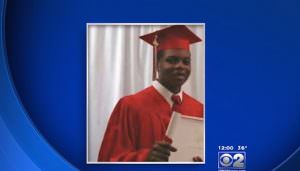This Nonviolent Stuff’ll Get You Killed
In 1946 Paul Robeson told President Truman that if the government refused to defend its black citizens, blacks would have to defend themselves. A new book, and history, reveal why Robeson’s words were so tragically prophetic.
Image by Basic Books
|
To see long excerpts from “This Nonviolent Stuff’ll Get You Killed” at Google Books, click here. |
“This Nonviolent Stuff’ll Get You Killed: How Guns Made the Civil Rights Movement Possible” A book by Charles E. Cobb Jr.
For several decades, I have taught the civil rights movement extensively in my UCLA class on the history of American social protest movements. I detail its effective use of nonviolence to challenge racist practices and white supremacy and to gain high moral visibility in major media outlets throughout the world. To the distress of many of my students, I also note that most civil rights activists, including myself, considered nonviolence merely a useful and moral tactic, but not a comprehensive way of life. Even more troubling, I proclaim my strong agreement with my fellow activists who respect and celebrate those who advocated and practiced self-defense whenever it was considered necessary.
A major new book on the history of the civil rights movement validates this perspective — a perspective ordinarily missing from conventional accounts — and adds a huge dimension to public understanding of the dramatic and continuing struggle against racism in the United States. Despite the widespread belief that everything changed because Dr. Martin Luther King (majestically) preached and acted nonviolently, leading to a “nonracial society” with the election of Barack Obama in 2008, the facts, as usual, are both more complex and more dismal.
Charles Cobb, a veteran civil rights activist who served as a field secretary for the Student Nonviolent Coordinating Committee, has set the record straight with his powerful narrative about Southern grass-roots black individuals and groups who played essential roles in African-American resistance. He reveals how they acted to protect black people and their allies throughout the ages with the careful use of violent self-defense methods. Although some historians and many civil rights veterans know the stories of these individuals and groups, they are invisible to the public and even to much of the scholarly community.
The tragic story of race in America is inextricably entwined with violence. Most of that history has involved white violence against blacks, starting from slave days and continuing to the present. The dramatic cruelty of slavery and the Jim Crow era is well recognized. White mob violence, the Red Summer of 1919 and race riots in many cities have also been well documented. Violent acts against sit-in and other civil rights demonstrators, including assassinations of leaders and civil rights participants, were widely disseminated on television and in newspapers. Cobb provides many horrific examples, adding details that reveal the understandable sources of historical and contemporary African-American rage. He includes anecdotes that complete the dismal picture, including narratives of the white “nightriders” who intimidated African-Americans attempting to register to vote, by shooting into their homes.
One of the key features of the book is Cobb’s history of black self-defense, especially in the 20th century. A major focus occurred with black veterans of World War I, World War II and the Korean War. These men put their lives at risk in foreign lands, fighting for ideals and constitutional rights that never applied to them because of their race. But as Cobb accurately notes, their service made them the least accepting of white supremacy and among the most dangerous opponents of racism in America — in part because they had been trained to use guns in the military and were willing to use them to defend their people. They were scarcely willing to put their lives on the line in Europe and Asia only to return home to second-class treatment and brutality in the United States. WWII veterans, including Mississippians Amzie Moore, Medgar Evers and Charles Evers, became major civil rights leaders. These men routinely carried weapons in attempts to deter white racist attacks. The 1963 killing of Medgar Evans unfortunately showed that these attempts were not always successful.
During the height of civil rights activities in the South in the ’60s, nonviolent activists usually knew that local blacks often kept guns for protection. They were also aware that these weapons would never be used offensively against local bastions of white supremacy. That would be foolish, inevitably resulting in far more repressive countermeasures.
Organizers and workers from the Student Nonviolent Coordinating Committee and the Congress of Racial Equality understood that direct actions at lunch counters, in front of department stores and in registering black voters required nonviolent discipline. That vision was entirely faithful to organizational missions and requirements, and was responsible for the success of many of the movement’s specific campaigns. At the same time, they felt a sense of security and protection, knowing that some armed black community members were watching over them.
Civil rights activists, in fact, had no power — or legitimate authority — to interfere with the right of local black community members to defend themselves violently if necessary. Cobb uses an effective example to drive that point home. In 1965, in rural Mississippi, movement supporter Robert Cooper engaged in a shootout with KKK members when they attacked his home. Commenting on that dramatic event, Cooper said, “I felt that you’re in your house, ain’t botherin’ nobody; the only thang you hunting is equal justice. An’ they gonna sneak by at night, burn your house, or shoot in there. An’ you gonna sit there and take all of it? You got to be a very li’l man with no guts at all.” It is impossible to argue with that simple and eloquent perception. Cooper’s decision, like that of many others in the South of that era, reflected the best of American pragmatism: responding in the way that made the most sense in a particular situation, without regard to the philosophical conflict between violence and nonviolence.Two of the more important organized self-defense movements during the modern civil rights era are highlighted in “This Nonviolent Stuff’ll Get You Killed.” These are also insufficiently known, even among many civil rights veterans. Their inclusion in this volume adds an especially valuable component to our historical understanding of those morally and politically compelling times.
The first is the story of Robert Williams in Monroe, N.C. Williams was also a World War II veteran whose dramatic activities reflected a vibrant African-American community that refused to bow to the racism that surrounded and oppressed it. Williams was the most visible personality, among many, in Monroe. As a local leader of the NAACP, Williams organized self-defense units against Klan motorcades intent on attacking and intimidating black people in Monroe. This armed self-defense strategy drew national attention, but created discord with the national NAACP leadership.
Williams argued for the necessity of organized self-defense in a famous exchange with King in 1959 issues of Liberation magazine. Eschewing violence for its own sake and acknowledging King’s moral leadership, he maintained that Southern blacks had to confront savage violence with defensive violence. Likewise, he repudiated the use of force for the sake of reprisals against whites and recognized that King’s passive resistance could be extremely effective.
The Williams/King conflict represented more than a mere ideological difference. Williams was a gruff working-class Marine veteran and King was a respected minister of the Baptist church and member of the African-American elite class. At its core, the conflict was as much about social class as philosophy. Still, the national NAACP scornfully dismissed Williams, and he eventually fled the country for Cuba to avoid prosecution on a trumped-up kidnapping charge. In 1962, he published “Negroes With Guns,” detailing his Monroe experiences; this book became one of the key documents of the black power/black nationalist movement that followed the nonviolent phase of the modern civil rights movement.
Cobb’s book also details the story of the Louisiana-based Deacons for Defense and Justice. In 1965, that organization was formally incorporated. Its mission was to use guns for self-defense and to protect civil rights demonstrators if necessary. The major civil rights groups like SNCC and CORE were sympathetic to the Deacons but they were understandably ambivalent and not formally linked to the group. King’s Southern Christian Leadership Conference obviously could not endorse the Deacons, but some members there must also have felt some ambivalence. After all, King’s home had been bombed and many had excruciating memories of the 16th Street Baptist Church bombing that killed four young girls in Birmingham, Ala., just a few weeks after the historic March on Washington in 1963.
The Deacons had some tactical successes. They spread throughout Louisiana and into other parts of the South, mainly in Mississippi. They protected civil rights workers, whites as well as blacks. Indeed, many of the workers were unaware at the time that the Deacons were guarding them. They often learned of their existence many years later. I can address this point in deeply personal terms. I participated in civil rights work at the time in Louisiana, with no knowledge that committed armed black men were watching over my comrades and me. They were ready to pounce on our tormentors if necessary. I discovered the Deacons sometime in the 1990s, a revelation that has heartened me and enriched my overall experience of a time in my younger life.
Above all, the Deacons for Defense and Justice played a powerful role in liberating their community from the fear that had beset African-Americans for generations. This emotional consequence was a vital impact of that movement, perhaps even more durable than the concrete victories at lunch counters, voter registration offices and department store human resource offices. That is a central reason why their story, and those of the others represented in this volume, needs widespread exposure today.
Americans have an obligation to look at the longer history of racism and the resistance to racism. In a 1946 meeting at the White House, Paul Robeson boldly told President Harry Truman that if the federal government refused to defend its black citizens, blacks would have to defend themselves. A careful examination of Cobb’s book reveals why Robeson’s words were so tragically prophetic.
Regrettably, the need for vigilant self-defense in African-American communities and the controversy of nonviolence versus violence cannot be confined to an issue of mere historical controversy. The deplorable reality, even now, is that government agencies charged with protecting the lives of all their people, including their black citizens, are woefully derelict in fulfilling their responsibilities. The recent homicides of Michael Brown in Missouri, Eric Garner in New York and Tamir Rice in Ohio at the hands of police authorities only highlight deeper problems of continuing institutional racism. It ill behooves privileged white Americans, including university students, to preach piously about nonviolence while black lives remain in great peril.
Independent journalism is under threat and overshadowed by heavily funded mainstream media.
You can help level the playing field. Become a member.
Your tax-deductible contribution keeps us digging beneath the headlines to give you thought-provoking, investigative reporting and analysis that unearths what's really happening- without compromise.
Give today to support our courageous, independent journalists.




You need to be a supporter to comment.
There are currently no responses to this article.
Be the first to respond.